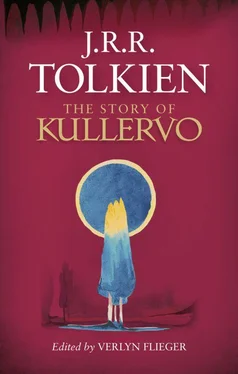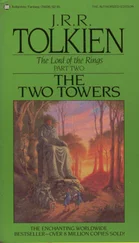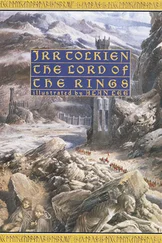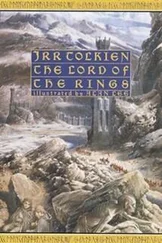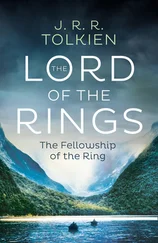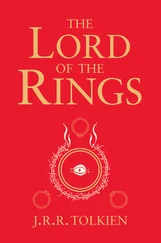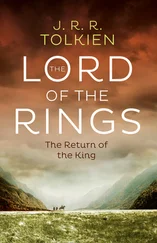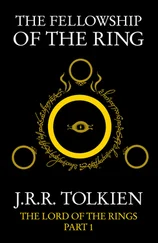8 for ill cradle rocking. The ‘for’ in this phrase should be taken to mean ‘because of’. The tradition that physical mistreatment of an infant could have psychological repercussions is an old one. Compare the saying, ‘as the twig is bent so grows the tree’.
one generation from the men of magic. Compare with Tolkien’s use of the word magic in the opening line, ‘when magic was yet new’. Kullervo is in touch with ancient shamanic practices.
not yet more than knee-high. Mythic heroes traditionally grow at an accelerated rate. Compare the Greek Hercules and the Irish Cú Chulainn. Wanōna, described as ‘wondrous’, also grows at an accelerated rate. In this respect, the twins may owe something to the classical Apollo and Artemis, twin children of Leto by Zeus. In some versions of their story both grew to full adulthood within the day of their birth.
9 hound of Tuoni. Hounds in mythology are frequently associated with the underworld, either as guardians or as guides. In Kalevala Tuoni is Death (personified) also called Lord of Death. His domain is Tuonela, the underworld, so-called from his name plus the locative/habitative suffix la .
10 Tuoni the marshland. Perhaps an error for Suomi. See entry for ‘Sutse’ above.
{ and to Kullervo he gave three hairs…} This entire sentence, cancelled in the manuscript, is retained in the present text since a magic hair of Musti’s later saves Kullervo’s life.
11 a [hundred] fathoms. The word in brackets is illegible in the manuscript, but ‘hundred’ is used in Kirby’s translation.
12 the great knife Sikki. In Kalevala the knife is not named. In his article ‘From adaptation to invention’ John Garth cites Tolkien’s Etymologies, a root SIK- with the Qenya and Sindarin derivatives sikil, sigil , meaning ‘dagger, knife’ ( Tolkien Studies Vol. XI 2014, p. 40, The Lost Road , 385).
13 Now a man in sooth I deem me. This is the first of the ‘chunks of poetry’ interspersed among the prose sections which Tolkien described ( Letters , p. 7) as his narrative style for The Story of Kullervo , and there are rough drafts among the note folios. It is in the so-called ‘ Kalevala metre’, that Tolkien would have known from the Kirby translation, in which he first read Kalevala . This is a rendering into English of the Finnish four-beat eight-syllable line, and is most familiar to English-speakers as the metre of Longfellow’s Hiawatha . It is less monotonous in Finnish. Alternate versions of the poem appear on folios 22 recto and (upside down) on the verso.
14 Lempo. Described in Folio 6 as ‘plague and desolation’. The name is confusingly close to the Kalevala name for Lempi , father of the playboy hero Lemminkäinen. Finnish lempi is ‘erotic love’. Tolkien has borrowed the name but not the meaning.
16 daughter of Keime. Obscure. Possibly a reference to Russia, called Kemenūme in the text; alternatively a possible reference to Teleä/Karelja, glossed in Folio 6 as ‘land of Kēme’s birth’.
17 the smith Āsemo. The name Āsemo is apparently Tolkien’s invention to replace the Kalevala name for this character, Ilmarinen , formed on ilma , ‘sky, air’. Āsemo may be formed from Finnish ase , ‘weapon, tool’ (he is, after all, a smith) with the suffix mo , used to change a noun into a proper name. In Kalevala the smith Ilmarinen has a far greater role, hammering out the lid of the sky and forging the magical Sampo, actions which qualify him as a kind of creator-god, but might have made him too potent a figure for his minor role in Tolkien’s story. Mythic heroes such as Kullervo are often fostered out to smiths; for example the Irish Setanta was fostered to the smith Culann from whom he took the name by which he was thenceforth known, Cú Chulainn, ‘Hound of Culann’. The Norse hero Sigurd was mentored by the smith Regin. Puhōsa, the smith’s homestead, is hard to locate geographically. It is said at various times to be in the Great Lands identified in the opening paragraphs as Russia, but also in Telea, identified with Karelja.
18 swart and illfavoured. It is Tolkien’s invention to have his hero’s angry and resentful internal emotional state externalized in his dark and ugly outward appearance. In Kalevala , Kullervo is described as handsome and yellow-haired. Folio 23 recto contains the marginal note ‘Kullervo ugly’ and beneath it, also in the margin, ‘Mauri black’.
20 thralldom. Slavery, serfdom, state of bondage. From Anglo-Saxon thræl , from Old Norse thræll , ‘servant’.
daughter [of] Koi Queen of the marshlands. The smith’s wife, in Kalevala called Pohjan neiti , ‘North maid, North miss’, is unnamed in Tolkien’s story, identified only as the daughter of Koi. In Finnish koi is not a proper name but a word meaning ‘dawn, daybreak’, so this usage is Tolkien’s invention. Although Koi does not appear in the story, Tolkien describes her in the name-list as ‘Queen of Lōke’ (see below). Tolkien clearly means the character to be equivalent to Louhi, a major character in Kalevala , where she is a sorceress, the Mistress of Pohjola the Land of the North, and the scheming mother of the North maid. The name Louhi is a shortened form of Loviatar , minus the feminine suffix tar . In Kalevala , Loviatar is called Death’s daughter, the half-blind daughter of Death’s Domain. One of Tolkien’s name-lists identifies ‘Louhiatar’ as ‘name of smith’s wife’ (see entry for ‘Kivutar’ below).
Puhōsa. Untamo’s homestead. Also called Puhu, perhaps as a diminutive.
21 blue woods/Blue Forest. Finnish sininen salo translates literally as ‘blue wilderness’, but is often translated ‘hazy blue wilderness’ or ‘blue woodland haze’, the result of rising mist in forested areas and especially in low-lying ground. Tolkien associates the colour and the phenomenon with mystery and magic — blue Puhōsa, the blue woods round Untamo’s dwelling, the Blue Forest of Kullervo’s wanderings.
22 Ilu the God of Heaven. Also called Iluku and sometimes confused with Ukko. In Tolkien’s list of names in Folio 6 (see below) Ilu is identified as the God of the Sky. Contrast with Malōlō below. It is worth noting that Ilu is also the initial element in Ilúvatar , the Elvish name for the godhead of Tolkien’s mythology, the ‘Silmarillion’.
Manatomi. Sky, heaven, also called Ilwe, Ilwinti.
Guard my kine. The longest of Tolkien’s ‘chunks of poetry’, this charm to protect cattle follows closely the incantation of equivalent length by the smith’s wife in Runo 32 of the ‘Kullervo’ portion of Kalevala , which Tolkien calls the ‘splendid kine-song’ (see essay and Notes). He clearly felt it to be an important element in both Kalevala and his own story. Both passages are testament to the importance of animal husbandry in a subsistence economy, and both, by their naming of the many woodland and nature spirits (though here Tolkien allows himself some poetic invention), give a good picture of the pagan Finnish worldview.
23 daughters of Ilwinti. Apparently air spirits, perhaps breezes. Ilwinti is formed from ilma, ‘sky, air.’ The mother goddess in Kalevala is called Ilmatar , ‘Maid of the Air’ (Magoun), or ‘Daughter of the Air’ (Kirby); literally ‘air maiden’ from ilma (‘air’) plus tar , the feminine suffix.
Читать дальше
